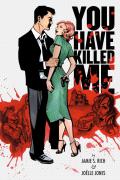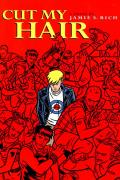
A fellow comics professional recently e-mailed me on behalf of a friend of his that was going to be moving to Oregon. He wanted to know how that friend might go about meeting up with other comics folk in Portland. "Easy," I replied. "All he needs to do is walk out his front door, point in any direction, and chances are, he'll be pointing at someone who works in comics."
It's a facetious answer, but only partly so. There are a lot of us here. Portland is lousy with comic book creators the way the ocean is lousy with salt. We have no less than three major comics publishers in the area (including my regular publisher, Oni Press), as well as several smaller up-and-comers, and a vibrant creative community. Vibrant enough, even, that both April of this year and last were declared Comic Book Month by the city to go along with the annual Stumptown Comics Fest. For all those reasons, it made total sense that Kevin Sampsell would want a comic book story in Portland Noir, and just as much sense that I would write one featuring cartoonists.
There is always a societal schism in crime stories, whether it's one that is implicitly stated or not. There is the basic divide between those who stay on the side of the law and those who step across the line to do crime. There is also the class separation of those who have something worth stealing and those who are going to steal it. While the two sides of the professional comic book world get along and are really more complicated in their nuances than a have-and-have-not distinction would imply, there are two faces to the professional coin, two types of creators in our industry. Just as our character in our Portland Noir story, "Gone Doggy Gone," points out, there are indie comics creators doing their own thing for sometimes little reward and there are the guys who work in superhero comics, usually earning more steady paychecks doing work-for-hire. Don't take that as a value judgment, the art form would not be what it is without both types of creator, and as is implied in the story, each side often envies the other. It's only the amazing few who can jump back and forth between the two sides. (My talented collaborator, Joëlle Jones, is just starting to become one of those, bless her heart.)
 As a thematic paradigm, it also fit my neighborhood, the upper Northwest, an area I have lived and worked in for many years. In this, I have put a little of myself and my own knowledge in Craig, the story's protagonist. In the corner of the 'hood that I live in, the affluent, white liberal pseudo-suburb fades into the industrial area. On one side of a particular street, you might see fancy condos, while on the other side cheap studio apartments with a shared bathroom. Over here you have guys working in manufacturing who can't afford to shop over there in that fancy boutique. It's the comic book divide. Craig, the perpetually defeated autobio cartoonist vs. the guys who draw Superman and Spider-Man.
As a thematic paradigm, it also fit my neighborhood, the upper Northwest, an area I have lived and worked in for many years. In this, I have put a little of myself and my own knowledge in Craig, the story's protagonist. In the corner of the 'hood that I live in, the affluent, white liberal pseudo-suburb fades into the industrial area. On one side of a particular street, you might see fancy condos, while on the other side cheap studio apartments with a shared bathroom. Over here you have guys working in manufacturing who can't afford to shop over there in that fancy boutique. It's the comic book divide. Craig, the perpetually defeated autobio cartoonist vs. the guys who draw Superman and Spider-Man.
Not that Joëlle and I spend a lot of time dissecting this in "Gone Doggy Gone." It's merely the backstory I toyed with when I was thinking about the thematic specialness of the creative community in which I worked and the other community in which I lived. I put a similar dichotomy in the crime graphic novel that Joëlle and I have coming out in July, a 1930s slice of hardboiled goodness called You Have Killed Me. Our main character grew up a rich kid and is now a private detective. He tries to deny his past, but when he's hired to find his former fiancée, a debutante who disappeared a matter of days before she was to marry a textiles heir, the underworld and the upper crust end up exposed as not altogether different.
When you think about it, most comic book superheroes actually have a similar disparity between who they are and who they must often pretend to be. Is it so different for mild-mannered Clark Kent to hide the fact that he's Superman, or scrawny teen Peter Parker to sneak off and fight the bad guys as Spider-Man? These, too, are crime stories, it's just that the detectives don't carry guns and can see through walls.
Joëlle and I don't peddle in superpowered stuff in "Gone Doggy Gone" or, for that matter, You Have Killed Me. Our comics are earthbound and feature characters who can't fly out of trouble or tangle their enemies up in any kind of web. Though, just like Craig wishes he could get the big bucks of his superhero-drawing peers, I am sure he wouldn't have minded a super power or two in dealing with his criminal predicament. We've pushed him into that classic tight spot where a man sees what he thinks is an easy option for crossing over and ends up in a situation that he cannot handle. That simple-sounding scheme that seems too good to be true, as always, really is too good to be true. Many similar-type narratives filled the lurid pages of EC Comics' Crime SuspenseStories back in the 1950s. Maybe if Craig had studied up on his comic book history more, he could have stayed out of this mess completely.
 Then again, you also have to wonder what all those old EC guys would have made of Portland, with its strip clubs and hipsters and history of crime and corruption. It rains all the time, which is good for people who need to sit inside and draw. It also means that there is a regular cover of darkness, plenty of shadows for hiding in and plotting all kinds of dirty deeds. Given how unbalanced most writers and cartoonists are to begin with, it's a wonder we haven't formed our own organized crime organization. Beware the Four-Color Mafia!
Then again, you also have to wonder what all those old EC guys would have made of Portland, with its strip clubs and hipsters and history of crime and corruption. It rains all the time, which is good for people who need to sit inside and draw. It also means that there is a regular cover of darkness, plenty of shadows for hiding in and plotting all kinds of dirty deeds. Given how unbalanced most writers and cartoonists are to begin with, it's a wonder we haven't formed our own organized crime organization. Beware the Four-Color Mafia!
"Gone Doggy Gone" actually contains some nods to other members of Portland's funnybook family, capos in the saddle-stitched syndicate. The lead character Craig is named for Craig Thompson, though there is absolutely zero resemblance, either physical or in terms of personality, between our loser narrator and the talented and altogether stable cartoonist. That's sort of the joke, that the fictional Craig is light-years away from the creator of Blankets, one of the most delicate and wonderful comics you're likely to read; though Mr. Thompson would likely be a model of success for the invented Craig were that made-up toon-man ever to stop so shamelessly ripping off Peter Bagge. Naturally, the titular dog being named Blanket is also a wave in Thompson's direction.
The other "cameo" is also completely casting against type. In the coffee shop scene, the superhero artist with a speaking role is meant to look like Steve Lieber, artist of the fantastic crime comic Whiteout and its sequel Whiteout: Melt, books I was an editor on back in the day and written by another Portland denizen, Greg Rucka (and soon to be a major motion picture). Though Steve has done the occasional superhero book, he is anything but the kind of guy Craig makes his Portland Noir doppelganger out to be. On the contrary, Steve Lieber is a champion of creator rights and a shining example of doing things your own way. He's also a tremendous draftsman and a helluva nice guy.
 In fact, despite the puritanical drive to clean up comics in the 1950s, when politicians looking to get re-elected by claiming the things would rot our brains, most people in comics are pretty nice and relatively well adjusted. Maybe it's that we spend so much time dreaming up ghastly scenarios, that we manage to get revenge on the bullies and the powers that be in our printed fantasies about the little guy making good, that we don't need to go out and do such things ourselves. As far as scandal-ridden industries go, we rank pretty far down the list. The excitement I gave Craig in "Gone Doggy Gone" is probably going to be the most action he sees in his life. That is, until the next comic book convention, but never you mind that. What happens at Comic Con stays at Comic Con!
In fact, despite the puritanical drive to clean up comics in the 1950s, when politicians looking to get re-elected by claiming the things would rot our brains, most people in comics are pretty nice and relatively well adjusted. Maybe it's that we spend so much time dreaming up ghastly scenarios, that we manage to get revenge on the bullies and the powers that be in our printed fantasies about the little guy making good, that we don't need to go out and do such things ourselves. As far as scandal-ridden industries go, we rank pretty far down the list. The excitement I gave Craig in "Gone Doggy Gone" is probably going to be the most action he sees in his life. That is, until the next comic book convention, but never you mind that. What happens at Comic Con stays at Comic Con!